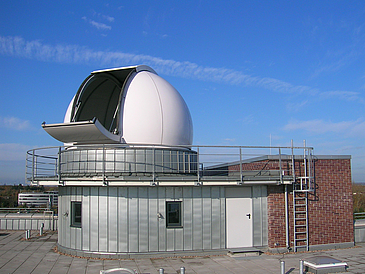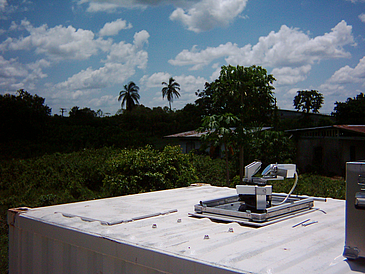Despite great progress in climate research in recent years, there are still uncertainties in predicting the climate in the future. For example, how much temperatures will rise in the coming decades and how precipitation will develop regionally. One reason for this: there is a lack of data and knowledge on short-lived components of the atmosphere, such as clouds, aerosol particles, and reactive gases, as explained by Dr. Mathias Palm of the Institute of Environmental Physics (IUP) at the University of Bremen. According to the latest report of the Intergovernmental Panel on Climate Change (IPCC), these still represent the greatest uncertainty factor in climate scenarios for the future.
Atmosphere Knows No Bounds
As a rule, short-lived trace gases only travel for a few hours to weeks in the atmosphere, in contrast to long-lived greenhouse gases such as carbon dioxide, which remain in the atmosphere for many years to decades. More is known about the effect of long-lived greenhouse gases than about their short-lived components, although the latter are also ubiquitous and have a significant impact on the climate. However, the impact of human activities on the atmosphere, from individual cars to huge forest fires, can only be estimated if measurements are taken continuously and over a large area at many points. The atmosphere knows no borders.
The European research infrastructure ACTRIS collects a large amount of data on these relevant components, how they interact with each other, and their changes on a national basis and brings them together centrally in a data portal. “This will create a research infrastructure that is unique in the world, providing data for analysis and prediction for use in science, politics, and business,” says Palm. ACTRIS-D will ensure the German contribution to the European research infrastructure ACTRIS.
Data Also Useful for Politics and Weather Services
In addition to major international organizations such as the World Health Organization (WHO) and the European Space Agency (ESA), ACTRIS also provides scientifically sound data to politics on the basis of which environmental policy decisions can be taken to help improve the living conditions of the population. Other user groups come from the public and private sectors – including weather services for the production of weather forecasts, but also companies that develop measuring instruments for aerosol particles, clouds, or trace gases.
Within the ACTRIS-D cooperation, almost all major players in German atmospheric research will work together – including universities, nonuniversity research institutes, and authorities. The German contribution to the distributed research infrastructure will consist of about 25 fixed and mobile observatories operated in Germany and at locations worldwide. These observation platforms are complemented by five simulation chambers that investigate atmospheric processes in the laboratory. Within the framework of ACTRIS, the IUP at the University of Bremen will contribute three fixed stations in Paramaribo/Suriname, on Svalbard, and in Bremen, as well as a mobile station that will be used at hot spots. Germany is also participating in the six European calibration centers, which will ensure that measurements can be carried out uniformly and at a high quality at all locations. Three of these calibration centers are to be managed by German institutes on the basis of existing knowledge. For calibration, the IUP is involved in the Centre for Reactive Trace Gases Remote Sensing.
Unique Pooling of Resources in Atmospheric Research
The German part of the European research infrastructure is coordinated by the Leibniz Institute for Tropospheric Research (TROPOS) in Leipzig. More than 120 institutions in over 20 countries work together at the European level. Such a large pool of resources has never before existed in atmospheric research.
German atmospheric research is thus in a position to make a significant contribution to the Pan-European research infrastructure. Conversely, participation in the Pan-European network is also of great importance for German research and will strengthen its worldwide reputation. Free access to data, publications, and services means that the scientific results will also benefit society in Germany.
ACTRIS-D Is One of Three New Research Infrastructures of the BMBF
In a three-stage process, the research infrastructure concepts submitted in Germany in 2016 were scientifically and economically evaluated by the Federal Ministry of Education and Research (BMBF) and their significance for society examined. With its inclusion on the National Roadmap – a kind of road map for the long-term orientation of top-level research – the Federal Government is expressing its fundamental willingness to promote these research infrastructures. The construction costs for the project amount to more than 50 million euros. The actual financing is provided by the responsible ministries depending on the available budget funds.
Participating Research Institutes:
• Leibniz Institute for Tropospheric Research e. V., Leipzig (lead institution)
• Alfred Wegener Institute (AWI) – Helmholtz Centre for Polar and Marine Research
• University of Wuppertal (BUW)
• Deutscher Wetterdienst (DWD), Offenbach
• Forschungszentrum Jülich GmbH (FZJ)
• Goethe University Frankfurt am Main
• Karlsruhe Institute of Technology (KIT)
• Ludwig-Maximilians-Universität Munich (LMU)
• Max Planck Institute for Chemistry (MPI-C), Mainz
• Max Planck Institute for Meteorology (MPI-M), Hamburg
• German Environment Agency (UBA), Dessau
• University of Bremen (UNIHB)
• University of Cologne (UCOL)
Further Information:
Press release of the Federal Ministry of Education and Research (BMBF) on the National Roadmap Research Infrastructures: https://www.bmbf.de/de/roadmap-fuer-forschungsinfrastrukturen-541.html
ACTRIS – the European Research Infrastructure for the observation of Aerosol, Clouds, and Trace Gases: https://www.actris.eu/
Contact:
Professor Justus Notholt
Institute of Environmental Physics
University of Bremen
Tel.: +49 421 218-62190
E-mail: jnotholt@iup.physik.uni-bremen.de
Dr. Mathias Palm
Institute of Environmental Physics
University of Bremen
Tel.: +49 421 218-62179
E-mail: mathiasprotect me ?!iup.physik.uni-bremenprotect me ?!.de


